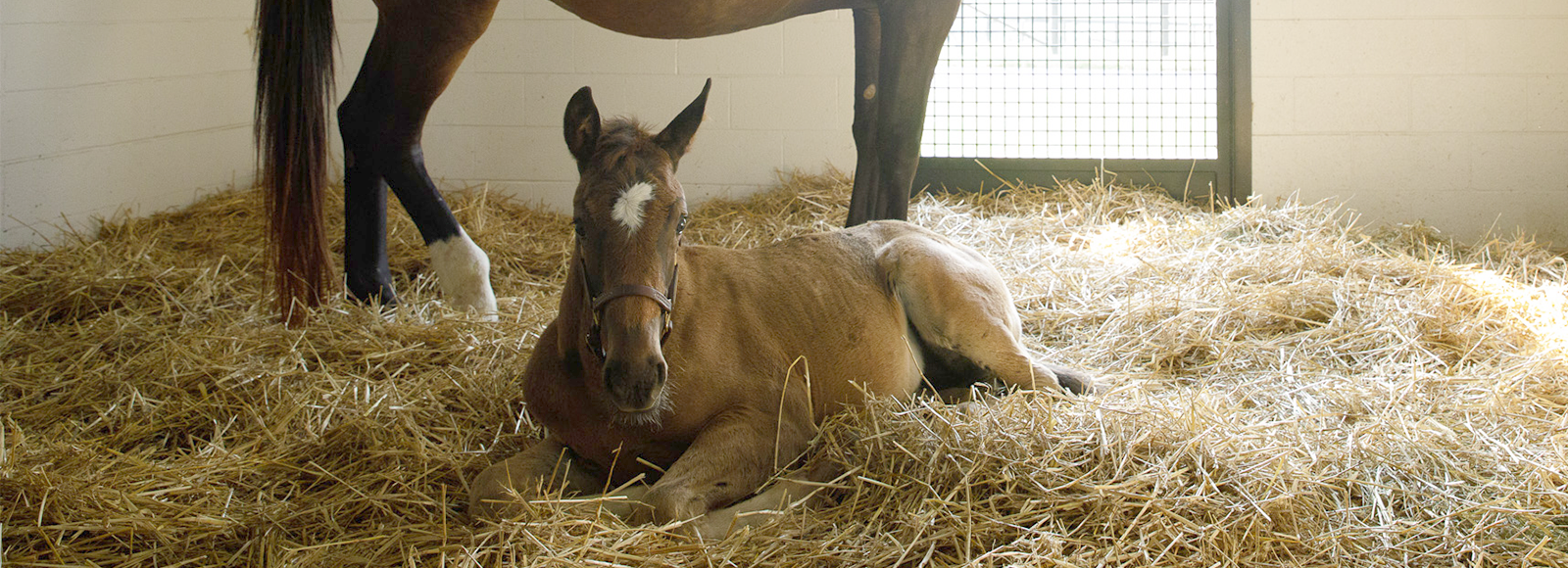
Equine Health Library
Broodmare
Foaling
Foaling | Post Foaling | Stallion Health
Foaling
Ovulation
Normal signs of impending delivery include gradual udder development two to six weeks prior to delivery. The mare’s teats wax within hours to a few days prior to foaling. Her mammary secretions change from clear and watery to opaque and sticky as delivery approaches.
Stage 1 labor – lasts about one to five hours
- Onset of mild uterine contractions
- Restless behavior
- Mild colic
- Tail switching
- Sweating
- Circling
- Lying down and rising
- Fetus is repositioning in preparation for delivery
- Cervix is dilating
- Most deliveries occur during evening hours
- If the mare is disturbed during this time, stage 1 labor may cease
Stage 2 labor – lasts about 10 to 30 minutes
- Begins with rupture of the chorioallantoic membrane at the cervix and is accompanied by the passage of a large volume of allantoic fluid.
- Followed by appearance of the white translucent amniotic sac at the vulva covering the foal’s forelimbs and head. The foal should be presented with both forelimbs extended (one slightly ahead of the other) followed by the outstretched head.
- Majority of mares will foal lying down.
- If your mare experiences prolonged labor without the delivery of a foal (greater than 30 to 45 minutes) or if the foal appears in an abnormal position, contact your veterinarian immediately.
Following rupture of the chorioallantoic membrane at the cervix and the passage of a large volume of allantoic fluid, the foal should present encased in the translucent white amnion with both forelimbs extended (one slightly ahead of the other), followed by the outstretched head. Once the fetal fluids have been expelled, delivery should progress rapidly, with the foal being born within 30 to 45 minutes.
If your mare experiences prolonged labor without the delivery of a foal – or if the foal appears in an abnormal position (with only one forelimb protruding, the head not appearing, or perhaps the hind limbs coming first) – contact your veterinarian immediately. Unless you are skilled in assisting a mare during a difficult delivery, it’s wise to wait for your veterinarian to arrive to avoid injury to you, your mare or her foal. Until then, it may be helpful to walk your mare in order to decrease unproductive straining.
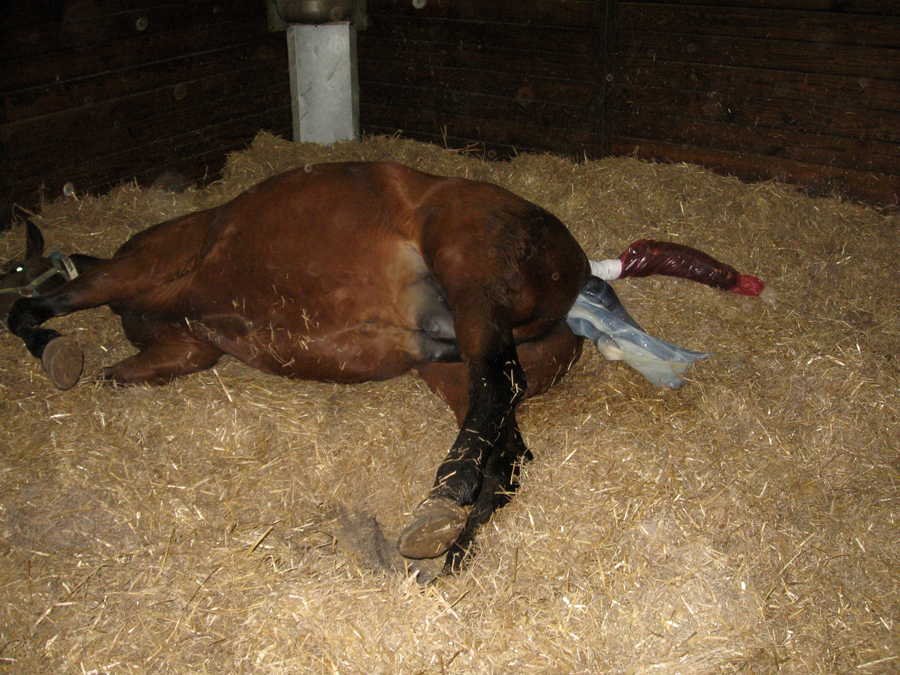
A normal delivery with the translucent amnion covering the forelimbs of the foal.
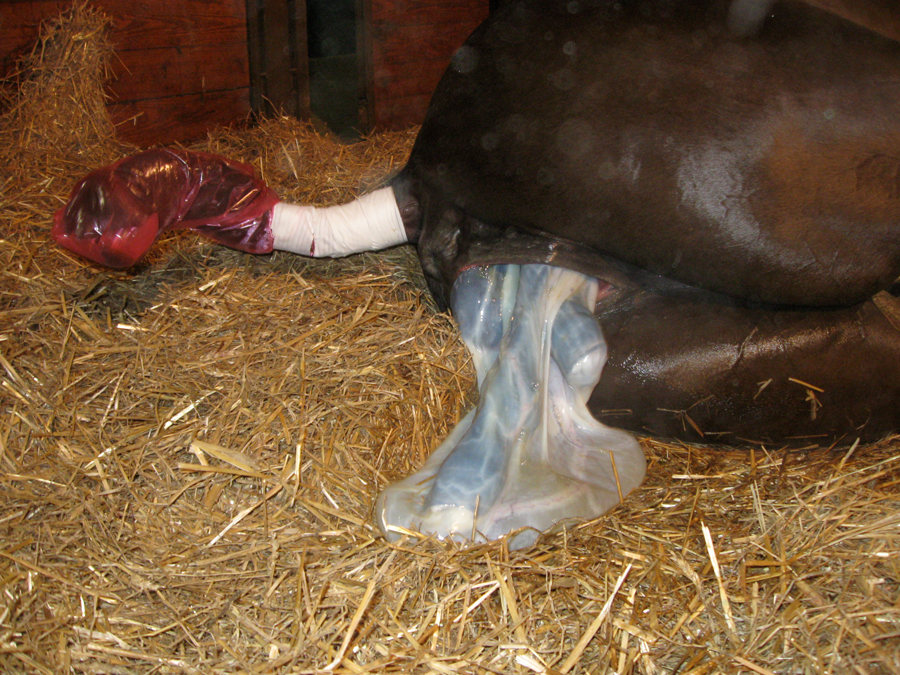
Foal delivery with the translucent amnion covering the forelimbs.
Stage 3 labor – should be complete within 3 hours after delivery
Your mare should pass her placenta within three hours of delivery. When she does, weigh, bag and save the placenta for your veterinarian to examine. The placenta should weigh approximately 10 percent of your foal’s weight. For example, if your foal weighs 100 pounds, the placenta should weigh approximately 10 pounds.
Heavy placentas are abnormal and could be associated with infection (placentitis) and premature placental separation (“red bag” delivery, resulting in disruption of oxygen and nutrient delivery to the fetus). A heavy placenta is a “red alert” and should prompt a call to your veterinarian for an early foal examination to look for any potential problems.
Emergency: “Red bag” delivery
One foaling emergency that you should be prepared to identify and act upon is a “red bag” delivery. Instead of seeing the thin white amniotic membrane covering the newborn foal, you will be faced with a velvety red membrane (chorioallantoic membrane) bulging out from the mare’s vulva.
During this emergency, the chorioallantoic membrane has failed to rupture at the cervix and has become detached prematurely from the inside of the uterus. As soon as this occurs, the foal stops receiving any oxygen from the placenta and is beginning to suffocate. If you do not act immediately, the foal will most likely die.
Have a trusted handler at the mare’s head to control her actions. Take a clean gauze pad or clean washcloth (something that will give you traction on the slippery membrane) and grab the heavy red, protruding membrane and pull it away from the foal inside. Tear the membrane open or use a blunt-ended bandage scissors to cut it open.
Once you rupture the membrane, a large volume of fetal fluids will be expelled, and you should see the foal within the amniotic sac. If the foal is in the proper presentation with his forelimbs extended and his outstretched head and neck visible, begin to apply gentle traction to the foal’s forelimbs in unison with the mare’s contractions (i.e., only pull on the limbs when the mare is actively contracting). Pull out and down following the natural curvature of the mare’s vagina.
When the foal is out, begin rubbing him briskly to stimulate breathing. If available, offer oxygen via a specialized mask. Have your veterinarian examine the foal as soon as possible for signs of hypoxia/asphyxia.
All newborn foals should receive a routine neonatal examination by a veterinarian within the first 24 hours. Early detection of disease and/or birth trauma in both the newborn foal and postpartum mare can be lifesaving.
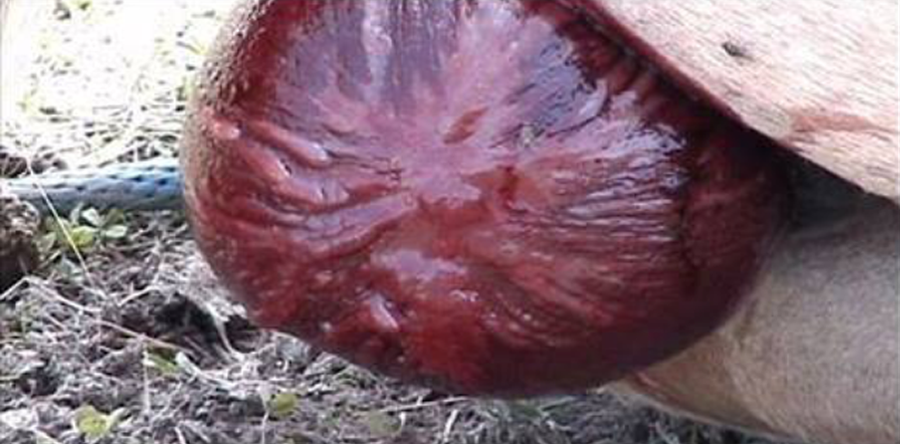
Red bag delivery of a foal.
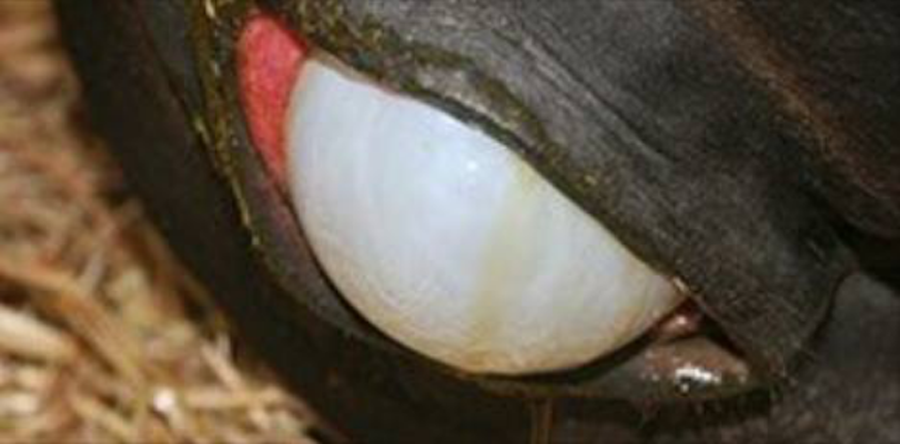
Normal delivery of a foal.
Post Foaling
Post Birth
Your veterinarian can evaluate the quality of the colostrum using a colostrometer or the Brix Refractometer. Your mare’s vaginal discharge should be thin and pink in color.
Good mare moms will show a keen interest in their foal, nickering frequently and smelling and licking their foal following delivery. This is an important period of bonding between mare and foal.
Any unnecessary traffic in and out of the stall should be avoided during the immediate post-partum period. During this time, the mare’s enlarged uterus is undergoing mild to moderate contractions as the placenta is expelled and the uterus begins to shrink in size.
This discomfort may distract some mares, especially maidens, from caring for their foals. Your veterinarian may recommend a low dose of an analgesic if this uneasiness takes your mare’s focus away from her foal.
Do not medicate mares without consulting your veterinarian since some pain post-foaling may be a sign of a more severe case of colic.
The birth canal is occasionally bruised or lacerated by the foal’s hooves. Most often, it happens to maiden mares, but it can also occur in some mares with large foals or during a dystocia. Vaginal bruising can have more serious side effects including difficulty urinating or defecating. The mare can experience great discomfort, but in most cases, it’s not life‐threatening. Impaction and/or severe constipation can result from reluctance to pass manure due to the pain associated with defecation. Consult with your veterinarian should your mare experience this problem.
Healthy foals try to stand soon after birth and should begin to nose around the dam looking for the udder. Maiden mares may need quiet encouragement during this critical period, particularly those new moms who may be a bit afraid of the wobbly newborn. Those mares may benefit from gentle restraint to keep still and to help the foal find the udder. Prior to letting the foal nurse for the first time, it’s a good idea to wipe off the udder and remove foaling secretions and dirt.
During the first few weeks post-partum, mares are at increased risk for colic caused by large colon torsion and impactions. Keep an eye on her, and watch for signs of colic (pawing, biting at sides, rolling, decreased manure passage) and monitor her appetite.
Lactation
Your mare will achieve peak lactation around four weeks post-foaling. This means her body is burning many calories to create food for her foal. Monitor your mare’s body condition and adjust feeding regimen (as needed) to maintain a body condition score of 5 to 7.
After the first two months of lactation, your mare’s milk may not meet the nutrient requirements of your foal. You can delay this downward plane by feeding a concentrate rich in fats or oils and high-quality protein. At this time you should begin foal creep feeding, if not already started.
Post-partum mares are at risk for several complications. Make sure you’re familiar with the signs of post-foaling complications.
Agalactia (lack of milk production)
Monitor your mare’s milk production to make sure she is not suffering from agalactia. This is commonly observed in mares that have been grazing endophyte (fungus) infected fescue grass or hay during late pregnancy. Other signs of fescue toxicosis include a prolonged gestation, difficult delivery, thickened placenta and the birth of a compromised foal. Therapy for reduced milk production typically includes administration of the medication domperidone.
Mastitis
Mastitis is uncommon in mares, but when it occurs, it is often characterized by a warm, swollen and painful mammary gland and abnormal mammary secretions. Affected mares frequently become systemically ill, stop eating and spike a fever. Therapy includes local treatment of the infected udder, systemic antibiotics and administration of anti-inflammatory drugs.
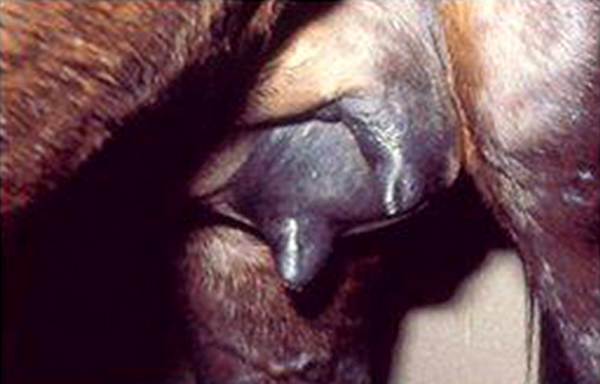
Enlarged, painful udder suggestive of mastitis.
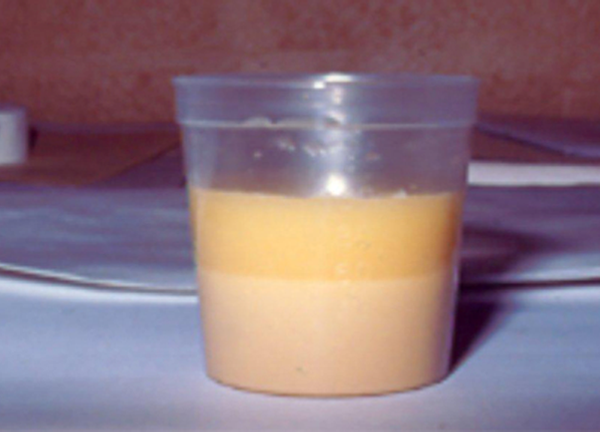
Discolored, infected milk sample.
Post-foaling complications
During the first few weeks’ post-partum, mares are at increased risk for several conditions. If your mare’s behavior bothers you in any way, contact your veterinarian and have your mare examined.
Retained placenta
During the post-foaling period, mares are at increased risk for uterine infection if the placenta has been retained for longer than three hours. Delayed passage of the placenta can be caused by placentitis, dystocia, twinning, abortion and Caesarean section. Complications associated with retained fetal membranes include metritis (uterine infection), septicemia (presence of bacteria and their toxins in the blood stream), laminitis and even death.
Contact your veterinarian if your mare has not passed her placenta within three hours of delivery. Therapy typically includes administration of oxytocin to stimulate uterine contractions and anti-inflammatory drugs to reduce the risk of endotoxemia. Additional therapy may include systemic antibiotics, uterine lavages and other treatments aimed at reducing the risk of laminitis.
Uterine infection (metritis)
A mare can develop a uterine infection from a retained placenta or from trauma associated with extensive manipulation of the foal within the mare’s reproductive tract during a difficult delivery. If your mare seems dull or depressed, or goes off-feed, take her temperature and her vital signs and notify your veterinarian. Uterine infection is usually accompanied by fever and a low or decreasing white blood cell count. Treatment includes systemic antibiotics, anti-inflammatory therapy and local treatment of the uterus.
Foal rejection
Foal rejection typically occurs within the first 24 to 48 hours following delivery. During this critical time, a mare’s mothering ability should be watched closely.
Forms of foal rejection
- Mares that accept the foal but will not let it suckle
- Mares that are fearful of the foal and run away when the foal attempts to nurse
- Mares that show unprovoked aggression towards the foal and will kick and bite the neonate
- Mares that lose interest in the foal if it is weak or sick
- Maiden mares are at increased risk for foal rejection
If the mare will accept the foal but walks away whenever it tries to nurse, the mare should be gently restrained for several nursings until she learns to stand quietly. Oxytocin released during nursing also will help improve maternal behavior. Always examine the mare and her udder to be certain that there is no painful reason that the mare is not allowing her foal to nurse. Sometimes warm compresses, gentle massage of the udder and small doses of oxytocin will help with milk let down.
Mares that are afraid of their foals require similar treatment, although some will also benefit from mild tranquilizers such as acepromazine to decrease their anxiety. If a mare is trying to bite or kick her foal, a grazing muzzle and hobbles may help prevent injury to the foal while you help accustom the mare to her foal. Overtly aggressive mares should be separated from their foals to prevent injury not only to the newborn but also to the handlers. In some instances, hormone administration can help modify certain adverse maternal behaviors. Your veterinarian can help decide a course of action for your mare.
Stallion Health
Stallion Soundness
The timing of all of these healthcare needs will depend on your breeding season, method of breeding and breed registry requirements. During the annual exam, no body system should be ignored. And throughout the season, all systems should be monitored for change in order to mitigate any negative impact on fertility or performance.
Breeding soundness starts with physical soundness, and musculoskeletal health is particularly important for breeding stallions. In order to perform their jobs, stallions need to be physically sound to mount mares or phantoms and thrust to ejaculation. Pay special attention to injuries or abnormalities in the hind limbs and the back. Often times, stallions have existing conditions as a by-product of former athletic careers.
Neurologic soundness is a must in stallion performance. Stallions with ataxia (incoordination) can be a danger to themselves, to mares, and most important, to breeding personnel during collection or cover. Your veterinarian should evaluate your stallion’s neurologic status annually and on an ongoing basis if concerns arise.
Breeding Soundness Exam (BSE)
Your stallion’s annual breeding soundness examination should focus on fertility. The BSE is important to both mare and stallion owners as a current BSE helps ensure mares will get in foal without risk of exposure to pathogens. A BSE helps stallion owners reduce their liability as well as form the optimal management and booking strategy to maximize fertility.
Your veterinarian should evaluate all factors affecting fertility: Libido, safe handling ability, mounting behavior, intromission and ejaculation.
Stallion semen should be evaluated for character, color, volume, concentration, motility, morphology and for presence of organisms causing infectious disease.
A minimum of two ejaculates are required to perform a semen evaluation. If you’d like your veterinarian to evaluate cooled or frozen semen, more ejaculates may be required prior to evaluation.
Your veterinarian will take and submit a bacterial culture on the stallion’s urethra (pre- and post-ejaculation), urethral fossae, sheath and semen. These cultures should be screened for known pathogens that may cause endometritis in the mare. If found, you should implement management practices to reduce, or eliminate, the effect on mares.
Additional testing is now available for semen of questionable viability, including chromatin and viability assays. Blood tests for Equine Infectious Anemia (EIA) and Equine Viral Arteritis (EVA) should be performed annually. Some stallions should be tested for Contagious Equine Metritis (CEM) as part of the BSE (consult your veterinarian for exportation requirements).
Your stallion should have an ultrasound examination of both testicles, including testicular measurement, for estimation of daily sperm output (DSO) and to detect pathogenic change affecting fertility and health. If specific problems are found through the BSE, your veterinarian may recommend internal ultrasound examination of accessory sex glands and endoscopic evaluation of the stallion’s urethra.
Breeding Strategy
Once the BSE is complete, your veterinarian can summarize the findings and help you formulate a breeding-season management strategy, which may include the stallion book size, breeding or collection dates, pre-breeding season treatments, ongoing management and semen-handling requirements.
The findings from a thorough BSE should give you an all-encompassing breeding strategy for the upcoming season with maximum fertility and minimal exposure of risk. This is why it’s so important to make sure the veterinarian performing the BSE has considerable skill, training and experience with stallion fertility.
Action item
- Schedule a yearly breeding soundness exam prior to breeding season.
Stallion Immunology
Your stallion has many of the same infectious disease risk factors as a performance horse – frequent exposure to both other horses and handlers who can transmit disease – plus the added risk of venereal disease transmission for breeds using live cover.
Viruses can risk breeding performance
Even semen-shipment containers received on-farm can expose stallions to infection. Yet, a stallion that gets sick with a fever has a consequence not seen in other horses: Reduced fertility.
Any elevation in body temperature above 102°F can damage sperm cells at all levels of maturity. It can take up to 60 days for the stallion to produce new, mature sperm cells and return to his former level of fertility. If this happens during the height of breeding season, it can be catastrophic to a farm.
Way to reduce risk of fever-causing diseases
- Reduce challenge from infectious organisms through biosecurity measures, such as quarantine periods, disease detection, housing, husbandry and hygiene
- Optimize immunity through nutrition, husbandry and proper vaccination
- Monitor stallions daily for fever and, if detected, treat promptly with non-steroidal anti-inflammatory drugs
Ask your veterinarian to customize a vaccination plan to your horse with both core vaccines and at-risk vaccines. Most studs benefit from being vaccinated before and after breeding season – and not during – to ensure fertility levels stay high.
Action item
- Vaccinate breeding stallions before and after breeding season depending on region and risk factors.
Stallion Nutrition
Throughout the breeding season, your stallion is working and can be considered a performance horse. As a result, he should be fed to maintain ideal body weight and condition (body condition score 5 to 6) and to support the demands of breeding performance.
Nutrition has a significant effect on stallion fertility, with energy derived from fat as a significant contributor. Stallion managers should use good nutritional plans and exercise to keep stallions in optimal breeding condition.
To read more about feeding for energy, visit our section on performance horse nutrition.
Senior Stallions
As your stud gets older, his reproductive performance and semen quality may decline. Plus, if he’s in a breed registry that requires live cover, your stallion may start to have trouble mounting mares due to underlying degenerative joint disease and/or lameness issues. Ask your veterinarian for a breeding soundness exam before every breeding season.
EVA (Equine Viral Arteritis)
Equine Viral Arteritis (EVA) is an especially problematic disease for stallion owners.
In most horses, EVA causes
- Fever
- Leg swelling
- Loose stools
- Reddening of mucous membranes
When infected, horses shed the EVA virus for three to 10 days. In pregnant mares, EVA often causes abortion, and in foals and weanlings, it can cause respiratory disease. When stallions are infected, however, they may become lifelong shedders of the virus via their semen. Stallions that shed the virus have no symptoms.
Unfortunately, there is no treatment for stallions shedding the virus.
Mares can become infected when covered or inseminated with infected stallion semen. Cooling or freezing of the semen does not reduce the virus’s ability to infect mares, which means the virus can spread to any geography via cooled or frozen semen.
Because no vaccine currently exists, control includes biosecurity and testing through blood work. A positive blood serum test indicates exposure or previous vaccination. In stallions where a positive blood serum test occurs with an unknown vaccination history, exposure must be presumed. Three ejaculates of the stallion’s semen can be evaluated, and if no virus is isolated, the stallion is considered negative (non-shedder) of the virus.
In the past, owners could breed mares to stallions shedding the virus after the mare was vaccinated. Because no vaccination now exists, mares should not be bred to stallions shedding the virus. Stallion owners need to take great caution to eliminate any exposure to this virus.
